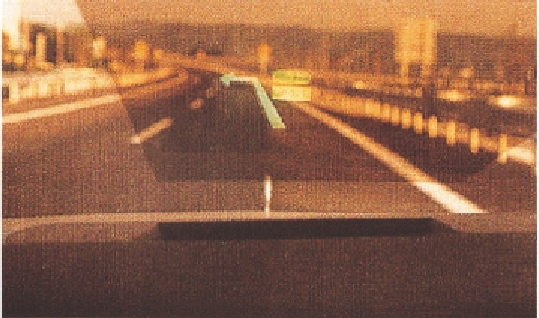Information Technology Reference
In-Depth Information
Figure 1. Example of a head-up display (HUD)
tors that emerge from these findings include:
display complexity; contrast/luminance; colour/s
choice; size of image/s; spatial location; and
virtual image distance. Perhaps the most important
design-related requirements are to consider care-
fully what and how much information is most
appropriate to present on a HUD. There are temp-
tations for designers to present ever-increasing
amounts of information on HUDs. However, in
contrast with traditional in-vehicle displays, a
HUD image, by its very presence in the driver's
line of sight, will demand focused attention (Bur-
nett, 2003).
plays and controls, ultimately aiming to ensure
good fit for the design population. However, driv-
ers sit in a constrained posture, often for several
hours and have limited physical mobility (e.g. to
comfortably viewing displays or reach controls).
Consequently, there is limited space within a ve-
hicle for the placement of a physical user-interface,
a key problem for designers hoping to implement
additional functionality within the vehicle.
To a large extent, this factor has fuelled the
development of multi-modal user-interfaces,
where a small number of controls, together
with menu-driven screens, provide access to
many functions within the vehicle. Clearly, such
visually-oriented user-interfaces are likely to
promote a considerable amount of “eyes-off-road”
time, and empirical studies have confirmed this
prediction (Dewar, 2002). Moreover, there is a
clear potential for users to mistake the current
mode (a well established problem in user-inter-
face design), and clear feedback is an important
design requirement (Preece, Rogers and Sharp,
2002). In many respects, there is a trade-off in
design between the number of discrete controls
that a user must scan within a vehicle and the
number of levels within a menu-based system
that must be explored and understood. This is a
very similar problem to that considered by HCI
researchers in the 1980s and 1990s interested in
Environments
The physical environment is also a specific area
that designers need to be aware of. In particular,
the light, sound, thermal and vibration environ-
ment within a car can be highly variable. A range
of design requirements will emerge from a con-
sideration of these factors, for instance, potential
for glare, problems with speech interfaces, use
with gloves, and so on.
From anthropometric and biomechanical per-
spectives, the vehicle cabin environment provides
many challenges for designers. This is an area in
which designers make considerable use of CAD
modelling to analyse different locations for dis-

Search WWH ::

Custom Search